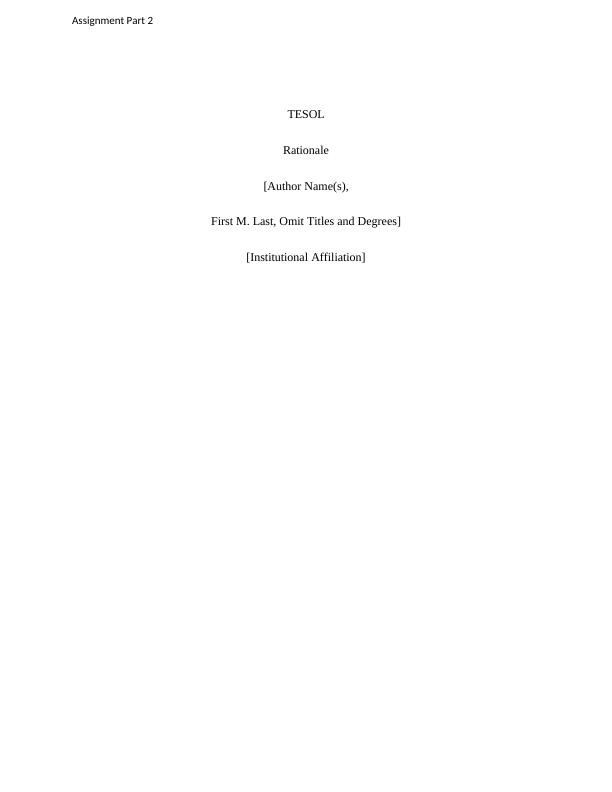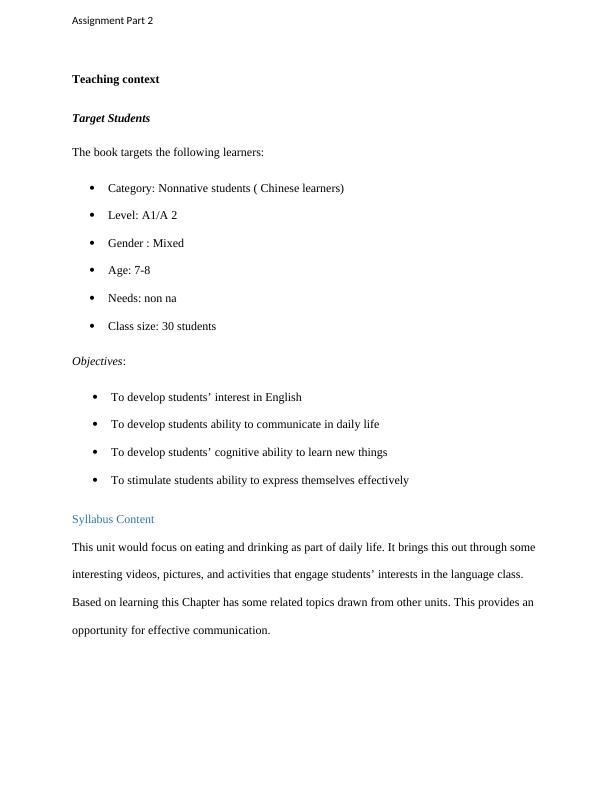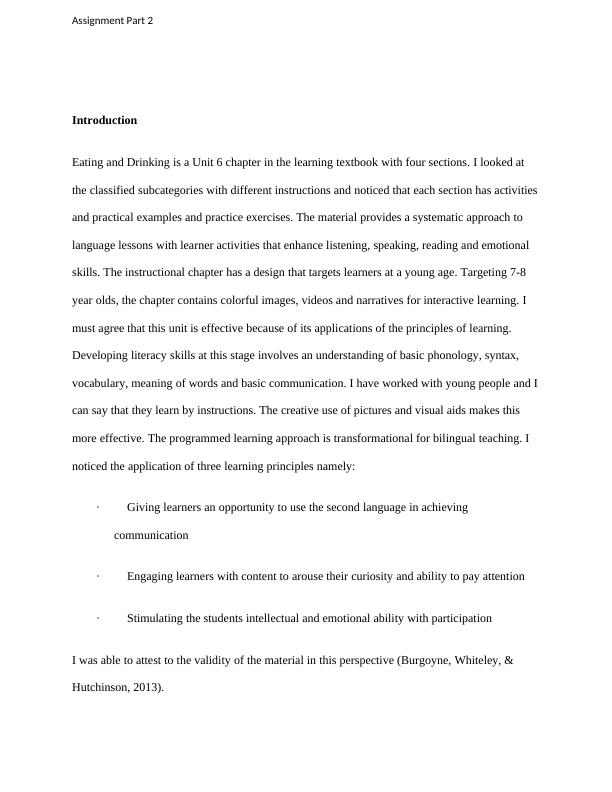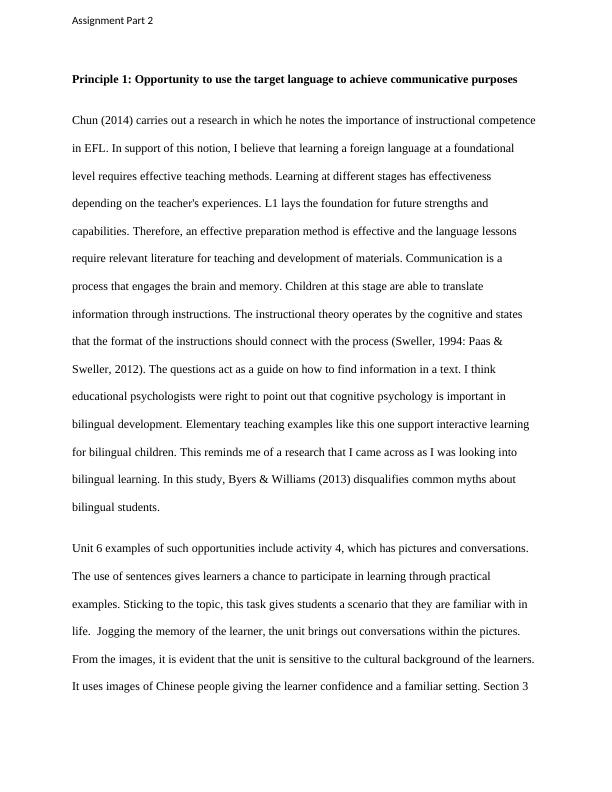Unit 6 - Eating and Drinking
11 Pages2816 Words49 Views
Added on 2021-05-31
Unit 6 - Eating and Drinking
Added on 2021-05-31
ShareRelated Documents
Assignment Part 2TESOLRationale[Author Name(s), First M. Last, Omit Titles and Degrees][Institutional Affiliation]

Assignment Part 2Teaching contextTarget StudentsThe book targets the following learners:Category: Nonnative students ( Chinese learners)Level: A1/A 2Gender : MixedAge: 7-8Needs: non naClass size: 30 students Objectives: To develop students’ interest in EnglishTo develop students ability to communicate in daily lifeTo develop students’ cognitive ability to learn new thingsTo stimulate students ability to express themselves effectivelySyllabus ContentThis unit would focus on eating and drinking as part of daily life. It brings this out through some interesting videos, pictures, and activities that engage students’interests in the language class. Based on learning this Chapter has some related topics drawn from other units. This provides an opportunity for effective communication.

Assignment Part 2IntroductionEating and Drinking is a Unit 6 chapter in the learning textbook with four sections. I looked at the classified subcategories with different instructions and noticed that each section has activitiesand practical examples and practice exercises. The material provides a systematic approach to language lessons with learner activities that enhance listening, speaking, reading and emotional skills. The instructional chapter has a design that targets learners at a young age. Targeting 7-8 year olds, the chapter contains colorful images, videos and narratives for interactive learning. I must agree that this unit is effective because of its applications of the principles of learning. Developing literacy skills at this stage involves an understanding of basic phonology, syntax, vocabulary, meaning of words and basic communication. I have worked with young people and Ican say that they learn by instructions. The creative use of pictures and visual aids makes this more effective. The programmed learning approach is transformational for bilingual teaching. I noticed the application of three learning principles namely:·Giving learners an opportunity to use the second language in achieving communication·Engaging learners with content to arouse their curiosity and ability to pay attention·Stimulating the students intellectual and emotional ability with participationI was able to attest to the validity of the material in this perspective (Burgoyne, Whiteley, & Hutchinson, 2013).

Assignment Part 2Principle 1: Opportunity to use the target language to achieve communicative purposesChun (2014) carries out a research in which he notes the importance of instructional competence in EFL. In support of this notion, I believe that learning a foreign language at a foundational level requires effective teaching methods. Learning at different stages has effectiveness depending on the teacher's experiences. L1 lays the foundation for future strengths and capabilities. Therefore, an effective preparation method is effective and the language lessons requirerelevant literature for teaching and development of materials. Communication is a process that engages the brain and memory. Children at this stage are able to translate information through instructions. The instructional theory operates by the cognitive and states that the format of the instructions should connect with the process (Sweller, 1994: Paas & Sweller, 2012). The questions act as a guide on how to find information in a text. I think educational psychologists were right to point out that cognitive psychology is important in bilingual development. Elementary teaching examples like this one support interactive learning for bilingual children. This reminds me of a research that I came across as I was looking into bilingual learning. In this study, Byers & Williams (2013) disqualifies common myths about bilingual students.Unit 6 examples of such opportunities include activity 4, which has pictures and conversations. The use of sentences gives learners a chance to participate in learning through practical examples. Sticking to the topic, this task gives students a scenario that they are familiar with in life. Jogging the memory of the learner, the unit brings out conversations within the pictures. From the images, it is evident that the unit is sensitive to the cultural background of the learners. It uses images of Chinese people giving the learner confidence and a familiar setting. Section 3

End of preview
Want to access all the pages? Upload your documents or become a member.
Related Documents
Sample Assignment on Tesol PDFlg...
|10
|2681
|748
Lesson Planning Assignmentlg...
|20
|4717
|68
Sentence Writing Strategy for High School Students with Learning Disabilitieslg...
|43
|4074
|336
12 Lesson Plans for Exploring the 1918 Chapter of My Placelg...
|40
|3764
|213
Assessing Prior Knowledge: Designing a Lesson on Language Learninglg...
|11
|2698
|176
Best Practices of Teaching EELslg...
|5
|1044
|85
